This Pasta Puttanesca, made with tomatoes, anchovies, capers, garlic, and olives, is a simple yet sophisticated dish that is packed with addictive salty, pungent flavours. A beloved Italian classic that gets dinner on the table in no time.
With the busy holiday season approaching, it is wise to have a few back-pocket dishes for easy weeknight cooking, or easy weekend entertaining. The kind of dish you can slap together on a crazy weeknight, or moments before friends are showing up at your door.
For me, pasta puttanesca is one of them. It is just about the easiest, most delicious pasta dish you can make and involves little to no technique. A bold tomato sauce made with briny capers and olives, salty anchovies and spicy red-pepper flakes forms the base of this traditional puttanesca. Tossed with a tangle of spaghetti, the punchy, flavourful pasta dish is utterly addictive and perfect for any day of the week.
What Is Pasta Puttanesca?
The literal translation of the Italian phrase “alla puttanesca” is “whore’s-style”. Not surprisingly, there are infinite stories of how this humble, colourfully-named pasta dish came to be.
Some say it was created by ladies-of-the-night to lure in customers. Others say these same ladies created the quick and easy pasta dish to feed themselves between clients. A more plausible explanation is that the owner of a restaurant made it for his hungry friends late one evening when they implored him to make them “una puttanata qualsiasi” – (any type of garbage!).
Wherever it came from, pasta puttanesca is a much loved Italian classic pasta dish and has been a go-to of ours for years. A weeknight lifesaver, it uses ingredients you likely already have in your pantry and the process to make it couldn’t be simpler. While the pasta is cooking, sauté a hefty amount of garlic in olive oil until fragrant and just sizzling. When you add in the anchovies, the pan should be medium-hot so the anchovies slowly dissolve, not fry, alongside the garlic. The capers, chili flakes, and olives go in next so the heat releases all their oil and lovely flavour. Lastly, the tomatoes are added to the mix and it takes minutes, not hours, for the sauce to be ready.
Garlicky, punchy, briny, and dangerously addictive pasta puttanesca is sure to be a hit no matter who you serve it to. Round out the meal with a simple salad and chunks of crusty bread. So simple, and so gloriously good.
Ingredients And Notes
Particularly during the holiday season, I like to stock up on pantry ingredients that are essential for easy weeknight meals, or for last minute entertaining. Most of us already have plenty of canned tomatoes hanging out in the pantry, but olives, anchovies, and capers are a powerful trio when it comes to flavour bombs. They form the base of this ridiculously easy pasta puttanesca but they are also great for breathing a little life into chicken dishes, salads, grain bowls, or to add to charcuterie boards. My advice, stock up!
Here is what you’ll need for this easy pasta puttanesca:
- Pasta – Spaghetti is the pasta most commonly used to make puttanesca and it is what I always use. Feel free to use any other pasta shape, if you wish. Gluten free pasta is great for this recipe. I have really been enjoying this brand. More pasta tips in section below.
- Extra virgin olive oil – Pasta puttanesca has few ingredients so try and use the best you can afford. The olive oil doesn’t have to be the best on the market, but maybe splurge on something a little above supermarket grade.
- Garlic – I like puttanesca with a lot of garlic but you can use less if you prefer. The garlic is best thinly sliced as opposed to minced so that it doesn’t burn as easily. I like to thinly slice it, then give it a very rough chop.
- Capers – Capers are the little flower buds of the caper bush. Preserved in a salt brine, or a pickle brine, they lose their bitterness and add a unique and delicious dimension to any dish. Capers stored in salt are tastier than those stored in brine but they are harder to find. If you use salted capers, just be sure to rinse them well before using. If using capers preserved in brine, drain the capers before using.
- Anchovies – This recipe calls for 4 anchovies, and if you love them, I recommend you add a few more. Note that even if you aren’t a huge fan of anchovies, you shouldn’t use less than 4 or your puttanesca sauce will not be as flavourful. See more on anchovies in section below.
- Black olives – I like to use oil-packed, unpitted Kalamata olives for my pasta puttanesca. Unpitted olives are less salty, tastier, less mushy, and more pleasant to the palette. You can pit them yourself if you are serving this dish to guests, but even then, I almost never pit them. If you need more convincing on always buying unpitted olives, this quick read might do the trick. Again, good-quality olives will do wonders for this dish. Others worth seeking are the smaller, but so flavourful, Italian gaetas, or dry-cured, oil packed such as these ones.
- Crushed red pepper flakes – Optional, but the tiny bit of spiciness is barely detectable and the chili flavour is just really nice here. Use as much or as little as you like.
- Canned tomates or passata – I have made this recipe with canned whole tomatoes, or with jarred passata and I enjoy the results of both. Bear in mind that puttanesca sauce shouldn’t be too heavy with tomatoes so it doesn’t overwhelm all the other ingredients. See more on what are the best tomatoes to use in section below.
- Fresh parsley – Add some chopped leaves at the very end, to garnish and give some fresh taste.
Note: The absence of cheese on the ingredient list is not a mistake. Pasta puttanesca is among only a handful of pasta dishes that I don’t finish with showers of grated parmesan or pecorino cheese. Not just because the pasta has fish (I subscribe to the no cheese on fish camp) but because it is such a savoury and flavourful dish that you really don’t need it.
Anchovies And Alternatives
“Just a little caper and anchovy can transform bland or oily dishes. We should carry them around in a little envelope, like a sewing kit, for culinary emergencies.” – Niki Segnit, The Flavour Thesaurus
For pasta puttanesca, you must set aside all your anchovy reservations (this coming from someone that doesn’t adore anchovies). But for this dish, they are absolutely indispensable. Once they dissolve into the sauce, the intense fishiness disappears leaving behind only a rich savouriness that heightens all the other flavours.
Think of it this way, worcestershire sauce has anchovies in it and you likely add it to many of your dishes. If you tasted it straight out of the jar, you likely would find it too strong. But once it cooks off, you’re left with all the savoury depth it imparts to the dish.
Much like capers, anchovies preserved in salt are superior in flavour to those stored in oil. That said, they are a lot harder to find so I use the ones packed in oil. If using anchovies stored in salt, they must also be rinsed well before using. To rinse them, place them in a bowl of water for 10-15 minutes. Drain them, then pat dry with paper towels to remove any extra salt.
For a vegan or vegetarian version of puttanesca sauce, you can replace the anchovies with a tablespoon of vegan worcestershire, or a tablespoon of white miso. In this case, I would also increase the amount of capers and/or olives.
The Best Type Of Tomatoes For Puttanesca Sauce
By now, it seems everyone knows that Italian, San Marzano tomatoes (with the designation DOP on the can) are the best canned tomatoes you can buy. The whole tomatoes are plump, wonderfully pulpy, and contain less seeds. I am quite loyal to these tomatoes but I know they can be pricey.
Some canned San Marzano tomatoes that are grown outside of Italy (without the designation DOP on the can) are less expensive and can be quite good, too. Use whatever you are comfortable with buying but try and avoid diced tomatoes which are almost always of lesser quality and have additives. You can of course use fresh tomatoes if they are season. Some recipes call for cherry tomatoes but I much prefer the bolder flavour of whole tomatoes and a jammier sauce.
Though my preference is canned tomatoes, I have also made the sauce using passata and it works great. My favourite passata is Mutti and I stock many jars of it in my pantry for making quick sauces.
How To Make Pasta Puttanesca
Delightfully easy, and so, so good, you’ll be making this pasta again and again. Here is the quick step-by-step:
- Start by bringing a large pot of a water to a boil. Once boiling, add a generous amount of salt.
- While you wait for the water to boil, start the sauce. Heat the olive oil in a large deep saucepan over medium heat. Stir in the garlic and sauté until fragrant and golden, about 1 minute. Add the anchovies and stir until they melt and disintegrate into the oil.
- Stir in the capers, crushed red pepper flakes, and olives and sauté for just about 1 more minute or so. Pour in the canned tomatoes and quickly help break them down with a wooden spoon or spatula.
- Boil the pasta until very al dente. Drain the pasta, reserving a cup or two of the pasta water. Alternatively, skip the draining and use tongs to transfer the slightly undercooked pasta to the saucepan. Toss with the sauce until throughly coated. Cook the pasta in the sauce for 1 or 2 minutes or until pasta is perfectly al dente. Remove from heat and serve immediately garnished with chopped parsley, if desired.
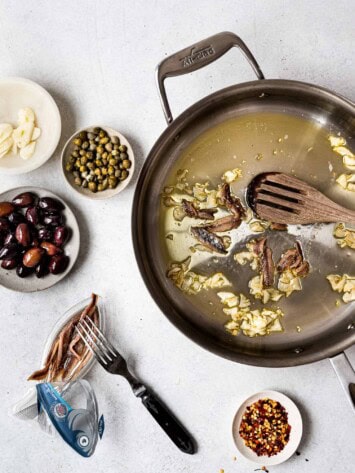
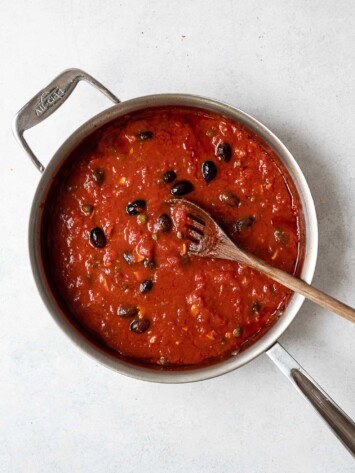
Pasta Tips
- Use dried pasta, not fresh. A good-quality dried pasta is a better choice here than fresh. Though I love fresh pasta, it just doesn’t hold up as well when tossed with the hot tomato sauce. Once again, a good-quality dried pasta will make a huge difference with taste and with how it holds up once tossed with the sauce.
- Generously salt the water. Despite all the salty ingredients in the sauce, the water should be salty enough to properly flavour the pasta. I use Diamond Crystal Kosher salt which is less salty than others (such as Morton’s or Windsor).
- Add the salt after the water has boiled. This prevents the salt from sitting at the bottom of pan which can cause the pan to pit.
- Undercook the pasta. Stop cooking the pasta when it tastes very al dente. In other words, almost uncomfortably al dente. Otherwise, it will be too mushy when it continues cooking in the hot sauce. A sure way to not overcook the pasta is to cook it 2-3 minutes less than the package instructs.
- Toss the pasta with the hot sauce. For pasta puttanesca, you want to always toss the pasta with the sauce before serving (as opposed to topping the pasta with sauce). This ensures all the noodle strands are thoroughly coated creating a more luscious dish.
- Reserve some pasta water. I always save pasta water in case the sauce seems a bit dry. It is also a great idea to save some of the water for reheating the pasta the next day.
- Skip draining the pasta. Use tongs to fish out the spaghetti strands and transfer them straight into the sauce. A little bit of excess pasta water clinging to the noodles is welcome.
Storing And Freezing Leftovers
If you have leftovers, consider yourself lucky. They keep well in the fridge for up to 4 days and make great lunches or a next-day repeat dinner.
What To Serve With Pasta Puttanesca
We almost always have our pasta puttanesca alongside a salad and some crusty bread. If I’m very organized, a side of oven-roasted broccolini is just about the best thing ever.
Other Quick Pasta Recipes To Try
- Pan Seared Scallops with Lemon Pasta
- Summer Pasta with Tomato and Shallot Confit
- Kale Sauce Pasta with Burrata and Peas
- Instant Pot Baked Ziti
If you give this Pasta Puttanesca recipe a try, please feel free to leave a comment and/or a star rating below. We appreciate and welcome all your feedback. Thank you!
Pasta Puttanesca
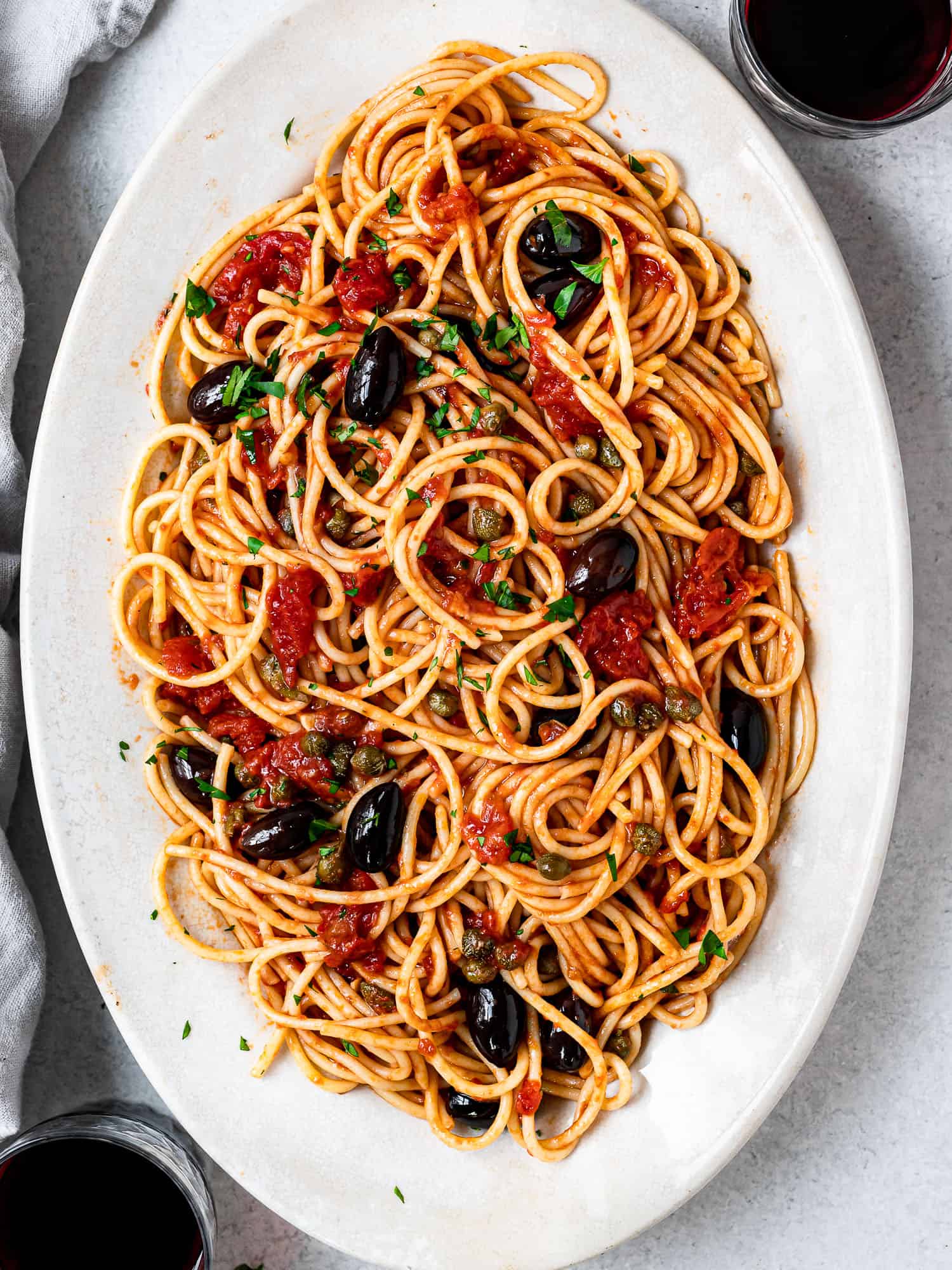
Ingredients
- 3 tablespoons extra-virgin olive oil
- 4 small cloves of garlic, or 2 fat peeled and thinly sliced
- 4 anchovy fillets (or more to taste) rinsed if packed in salt
- 3 tablespoons capers drained
- 1/2 teaspoon crushed red pepper flakes or more to taste
- 3/4 cup un-pitted black olives (I use Kalamata)
- 1 28-ounce can whole tomatoes
- Freshly ground black pepper to taste
- kosher salt
- 1 pound spaghetti, linguini, or other long pasta
- 2 tablespoons chopped fresh parsley optional, for garnish
Instructions
- Bring a large pot of water to a boil.
- While you wait for the water to boil, make the sauce. Heat the olive oil in a large deep skillet or saucepan over medium heat. Stir in the garlic and sauté until fragrant and lightly golden, about 1 minute. Add the anchovies and stir until they melt and disintegrate into the oil.
- Stir in the capers, crushed red pepper flakes, and olives and sauté for 1 more minute, or so. Pour in the canned tomatoes and quickly help crush them down with a wooden spoon or spatula. Raise heat to medium-high and cook, stirring occasionally until tomatoes break down and sauce has thickened slightly, about 10 minutes. Season with freshly ground pepper, to taste.
- Once water is boiling, add two tablespoons of salt along with the pasta. Cook, stirring occasionally, until pasta is al dente, about 2 minutes less than directed on the package.
- Drain the pasta, reserving a cup or two of the pasta water. Alternatively, skip the draining and use tongs to transfer the pasta directly into the sauce. Toss the pasta with the sauce until throughly coated and allow it to cook in the sauce for 1 or 2 minutes, adding a splash or two of pasta water. Remove from heat.
- Serve immediately garnished with chopped parsley, if desired.
Notes
Pasta Tips
- Use dried pasta, not fresh. A good-quality dried pasta is a better choice than fresh. Though I love fresh pasta, it just doesn't hold up as well when tossed with the hot tomato sauce.
- Generously salt the water. Despite all the salty ingredients in the sauce, the water should be salty enough to properly flavour the pasta. I use Diamond Crystal Kosher salt which is less salty than others (such as Morton's or Windsor).
- Add the salt after the water has boiled. This prevents the salt from sitting at the bottom of pan which can cause the pan to pit.
- Undercook the pasta. Stop cooking the pasta when it tastes very al dente. In other words, almost uncomfortably al dente. Otherwise, it will be too mushy when it continues cooking in the hot sauce. A sure way to not overcook the pasta is to cook it 2-3 minutes less than the package instructs.
- Toss the pasta with the hot sauce. For pasta puttanesca you want to always toss the pasta with the sauce until thoroughly coated.
- Reserve some pasta water. I always save pasta water in case the sauce seems a bit dry. It is also a great idea to save some of the water for reheating the pasta the next day.
- Skip draining the pasta. Use tongs to fish out the spaghetti strands and transfer them straight into the sauce. A little bit of excess pasta water clinging to the noodles is welcome.


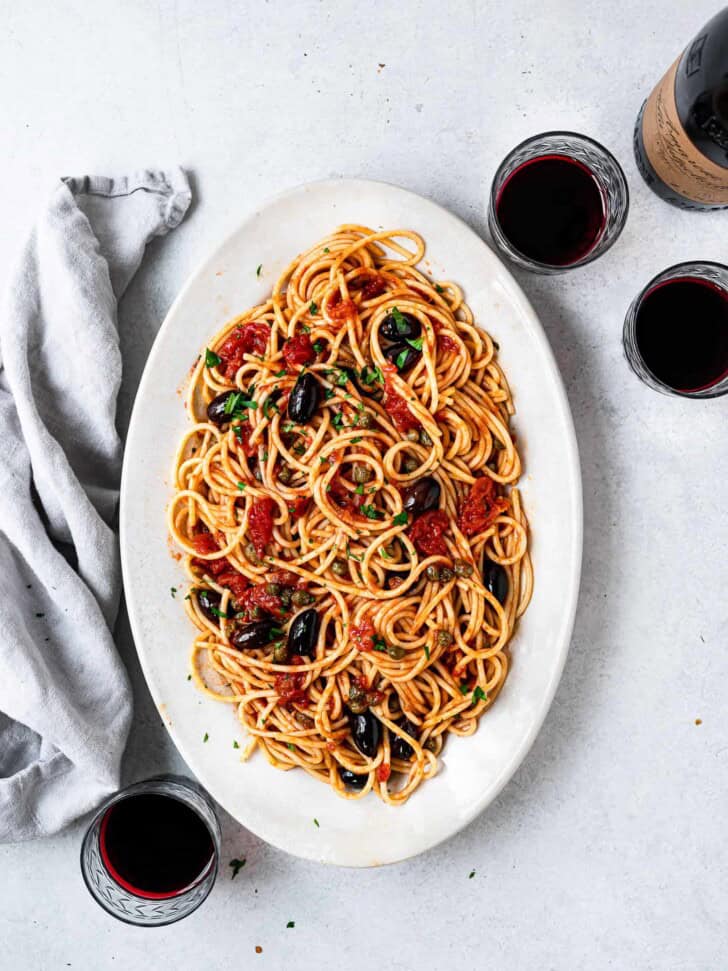
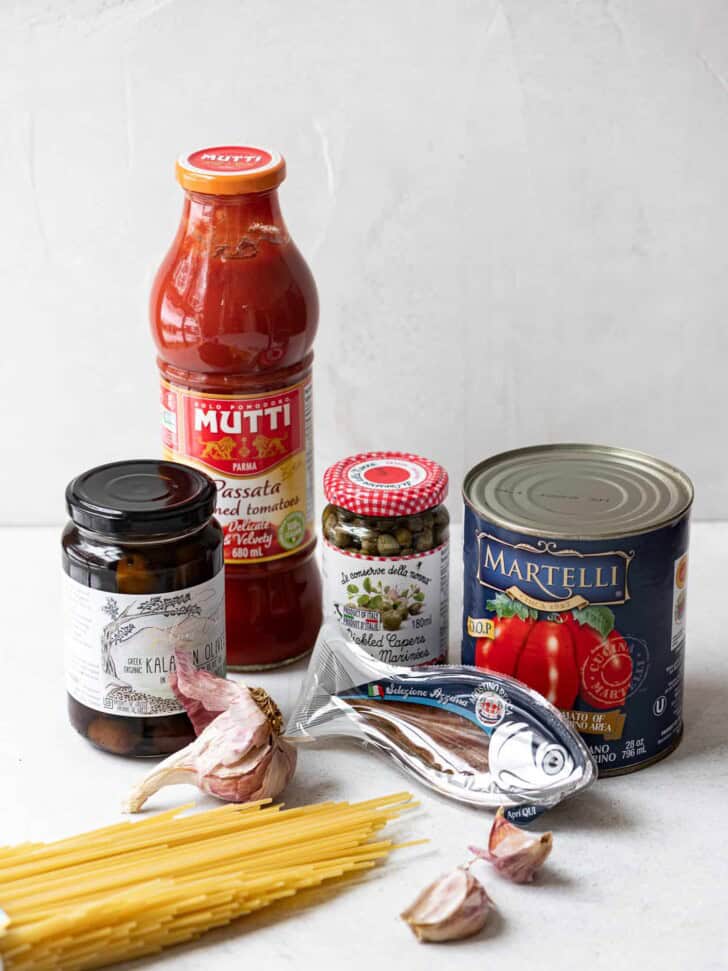
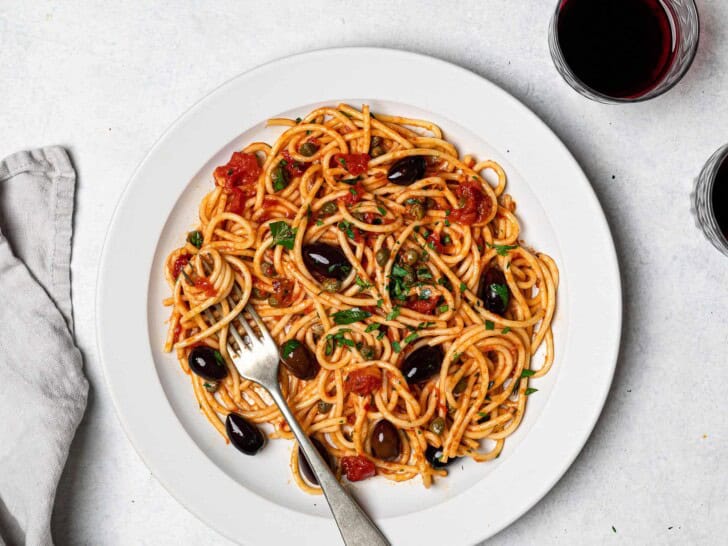
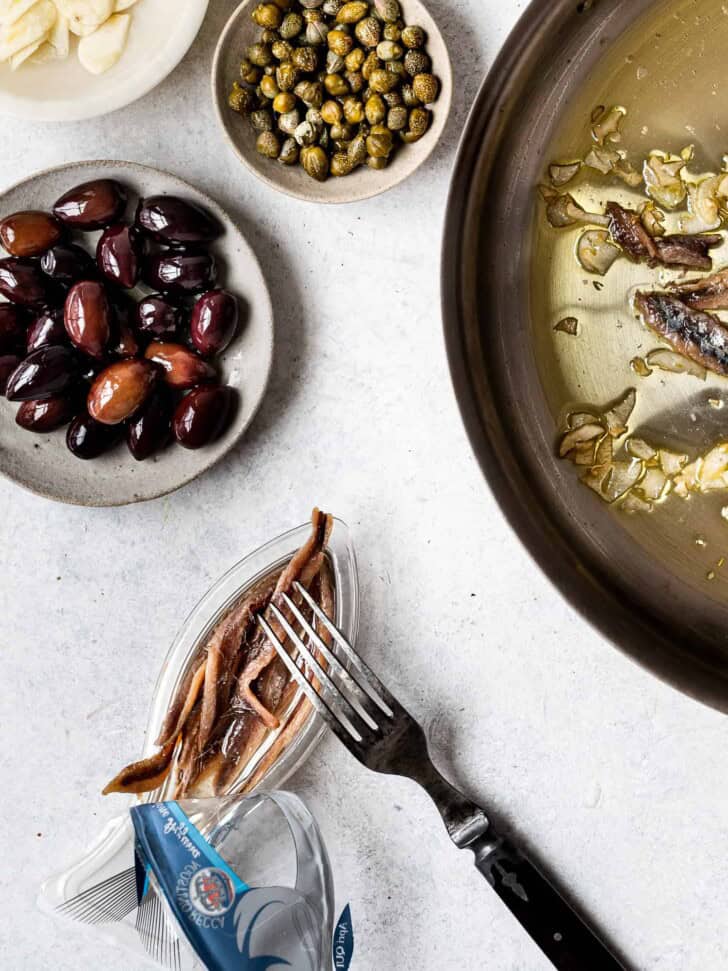
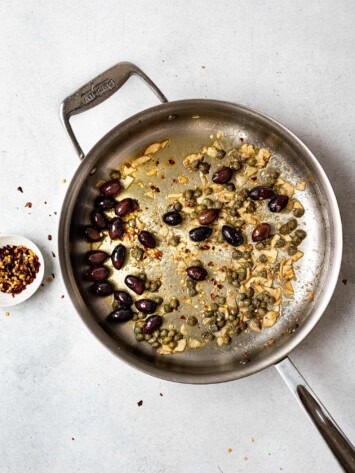
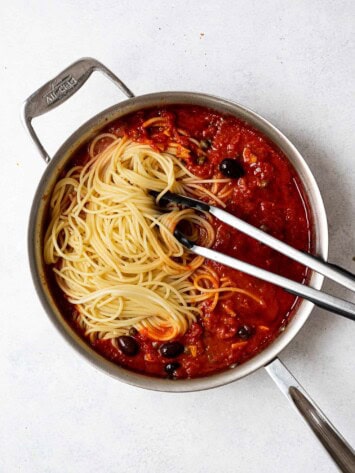
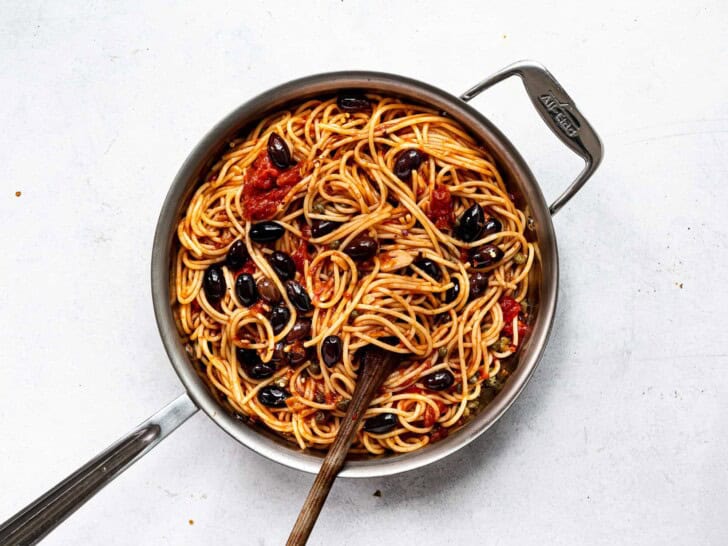
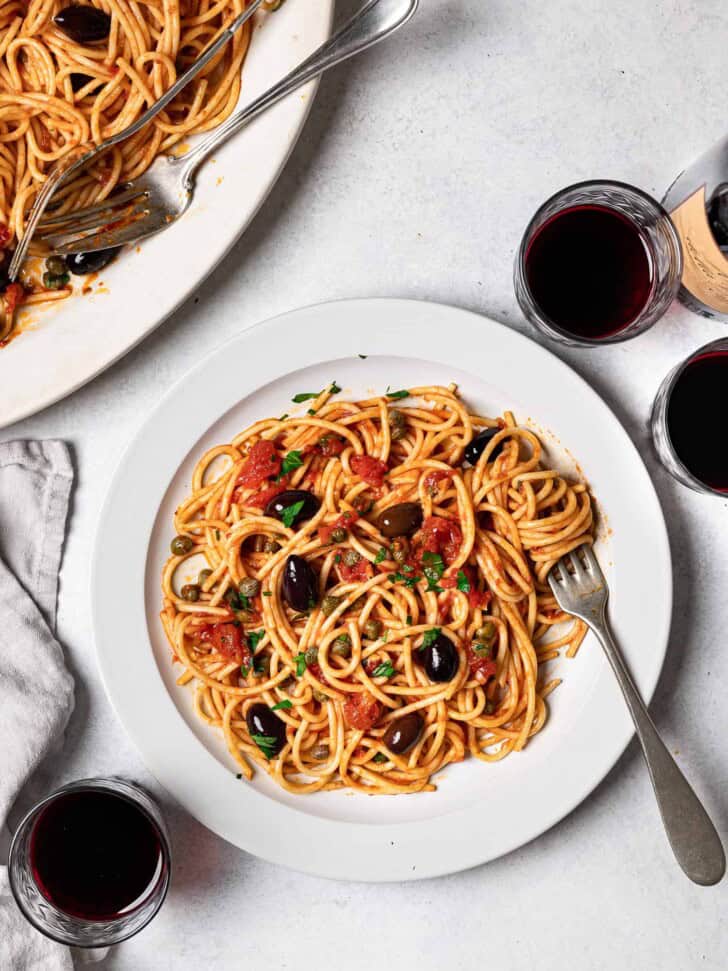
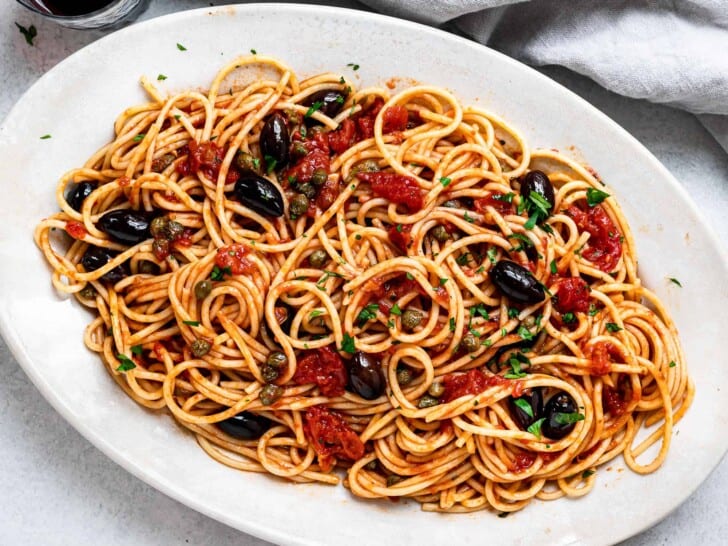

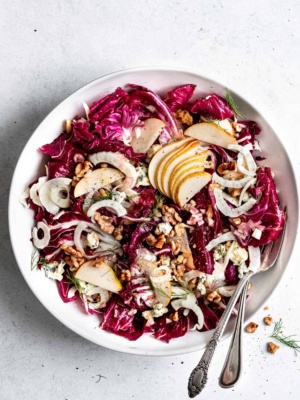

Join the Conversation